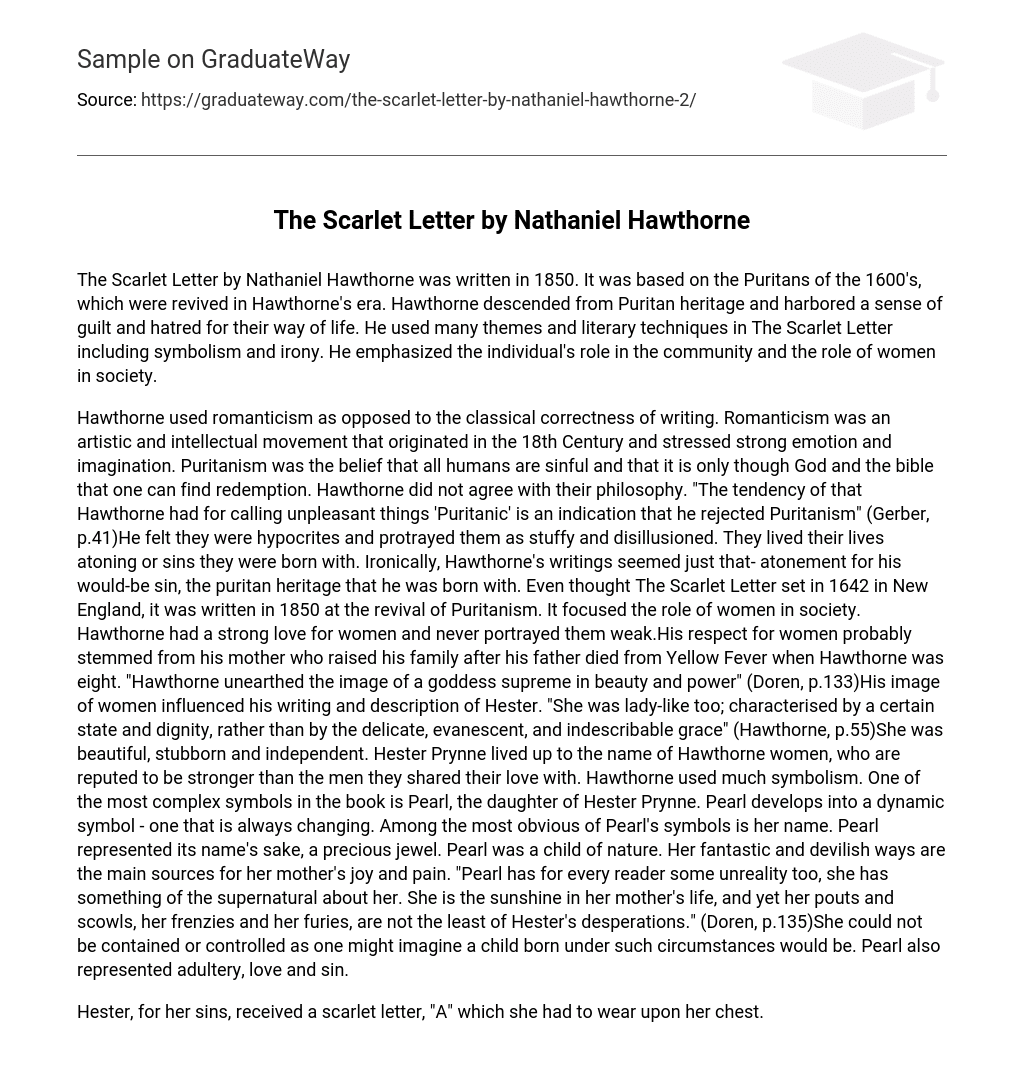Written in 1850, The Scarlet Letter is a novel that focuses on the Puritans of the 1600s, a group that experienced a revival during Hawthorne’s era. As someone with roots in Puritanism, Hawthorne carried feelings of guilt and resentment towards their lifestyle. In this work, Hawthorne uses symbolism and irony as literary devices to explore different themes. He specifically emphasizes the significance of an individual’s place within a community and the role of women in society.
Hawthorne chose to employ romanticism instead of conforming to conventional writing standards. Romanticism, a movement in art and intellect that arose during the 18th Century, emphasized strong emotions and imagination. Conversely, Puritanism was a belief system that considered all individuals inherently sinful and believed redemption could only be attained through God and the Bible. Hawthorne diverged from this philosophy by often referring to unpleasant things as “Puritanic” (Gerber, p.41).
Hawthorne portrayed the Puritans as hypocrites who lived their lives seeking forgiveness for the sins they were born with. Ironically, Hawthorne’s writings, including The Scarlet Letter, seemed to serve as his own atonement for the puritan heritage he was born into. Despite being set in 1642 New England, the novel was actually written in 1850 during a revival of Puritanism. It also focused on the role of women in society, a topic that Hawthorne respected and never portrayed them as weak. This respect for women may have been influenced by his mother, who raised their family after his father’s death from Yellow Fever when Hawthorne was eight. According to Doren (p.133), Hawthorne depicted women as goddesses of beauty and power.
Hawthorne’s portrayal of Hester in his writing was influenced by his perception of women. In his description, he stated, “She was lady-like too; characterised by a certain state and dignity, rather than by the delicate, evanescent, and indescribable grace” (Hawthorne, p.55). Hester possessed beauty, determination, and independence, fitting into the image of Hawthorne women known to be stronger than the men they loved. Symbolism played a significant role in Hawthorne’s work, with one of the most intricate symbols being Pearl, Hester Prynne’s daughter.
Pearl is a dynamic symbol, constantly changing. Her name, Pearl, represents a precious jewel. She is a child of nature and brings both joy and pain to her mother through her fascinating and devilish behavior. According to Doren (p.135), Pearl has an unreal quality, almost supernatural. She is the sunshine in Hester’s life, but also the cause of her frustrations with her tantrums and angry outbursts. Despite the circumstances of her birth, Pearl cannot be contained or controlled. She also symbolizes adultery, love, and sin.
Hester was given a scarlet letter, “A,” to wear on her chest as punishment for her sins. This symbolized her being an adulterer according to Puritan beliefs. As Hester walked through the streets, she faced judgment and contempt but eventually society moved on from her adulterous act. The once disgraceful “adulteress” transformed into a capable woman. She settled in a desolate area that mirrored her marginalized and undesirable status.
The landscaping in The Scarlet Letter carries symbolic meaning. The presence of a rosebush near the jail signifies significant symbolism as it represents Hester and freedom. Conversely, the deteriorated condition of the jail serves as a representation of puritanism and the detrimental impact it has on society. Similarly, Chillingworth embodies the negative aspects of love as he relentlessly seeks vengeance against Pearl’s father, being described as an embodiment of evil and malevolence. One quote in the book describes him as “an unreal thing, a villain, stooping as he walks…he is the devil again” (Doren, p.134).
A horrifying expression contorted the man’s face, resembling a snake swiftly sliding across it. His countenance quickly darkened with a strong emotion, which he managed to instantly suppress with sheer willpower, except for a brief moment where it appeared calm. After a short pause, the convulsion became barely noticeable and eventually disappeared into the depths of his being” (Hawthorne, p.63).
Chillingworth exemplified underlying malevolence, a dark force held beneath the surface, poised to emerge at any moment. Nathaniel Hawthorne’s novel, The Scarlet Letter, delved into the lives of the Puritans during the 1600s. Hawthorne carried a burden of guilt for his Puritan ancestry and despised their way of life. Through his writing, he employed romanticism and underscored the role of women in society. With a deep reverence for women, his perspective greatly influenced his literary works. Symbolism played a significant role in Hawthorne’s narrative, manifesting through character names, elements of the setting, and the scarlet letter itself. Despite Hester never fully reconciling with her own sin, she managed to achieve success and ultimately died as a woman held in high regard.





